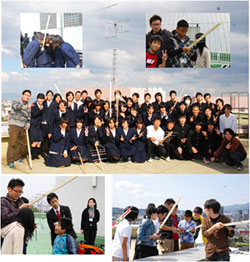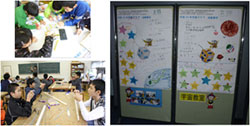QSL card application form
鳳龍四号の電波を受信していただき、誠にありがとうございます。
QSLカードの申請は以下の情報ご記入の上、下記メールアドレスへお願い致します。
- コールサイン
- 名前
- 郵便番号
- 住所
- 受信電波(CW(437.375MHz)、FM(437.375MHz)、S-band(2400.3MHz))
- 受信日
送信先メールアドレス:o349523h*mail.kyutech.jp (*は@)
頂いた情報は、QSLカードの発送のみに使用させていただきます。
Thank you for recieving HORYU-IV signal.
*Application of QSL card
Please send us following information. e-mail : o349523h*mail.kyutech.jp (please change from * to @)
- Call sign
- Name
- Country
- Postal cord
- Address
- Recieved signal (CW(437.375MHz) or FM(347.375MHz) or S-band(2400.3MHz))
- Recieved date
We ONLY use your information to send QSL card.
Important Notice
Dear amateur radio community,
We are very pleased to inform you that we obtained the final license for the satellite operations. We can now, officially, ask for your help to receive either the UHF band data (437.375MHz, CW 20wpm, FM 1200bps, FSK modulation) and S-band data (100kbps, 2400.3MHz, BPSK modulation).
Who knows, you might be the world first witness of on-orbit discharge on solar cells!
■ □ ■
- Launch Schedule → Click here for details(PDF file)
- 1st Pass Prediction → Click here for details(PDF file)
- ONE WEEK Passes Prediction → Click here for details and here(PDF files)
- Communication Sub-system → Click here for details(PDF file)
- TLE data from NORAD → click here(txt file)
■ □ ■
HORYU-IV Team aims at establishing a beneficial, constructive, and prosperous relationship with the radio amateur frequency community.
Through the use of amateur frequencies, HORYU-IV Team would like to inspire interest in radio communication, promote research on radio communications technology, and participate to the skills improvement of the beginners in radio communications. Including our own freshly licensed amateur radio members!
HORYU-IV Team envisions the radio amateur frequency community as a bridge between its non-profit missions’ outcomes and the general public.
HORYU-IV project is working in close collaboration with the Science and Mathematics Collaboration Center of Kyutech that organizes events with students from elementary to high schools, as well as with Kitakyushu Children Museum of Culture and Science.
During past events, the participants built yagi antennas, which allowed them to hear HORYU-II* beacon through amateur frequencies (see pictures below).
HORYU-IV carries the digi-singer (SNG) mission on-board, and thanks to it, participants would be able to send a song that will be processed on-board to be then sent back to ground through radio amateur frequency. The song could therefore be heard all around the world!
By establishing a beneficial, constructive, and prosperous relationship with the radio amateur frequency community, HORYU-IV Team hopes to positively contribute to the expansion of radio communication technology, deepen general public understanding in radio communications, and broaden young generation perspectives on how space could be used and how STEM (science, technology, engineering, and mathematics) is a key element.
*previous satellite developed at Kyutech and launched on May 18, 2012

Outreach activities at Kyutech

Kitakyushu Children Museum of Culture and Science
How to receive HORYU-IV signal?
For transmitting housekeeping data, and digi-singer mission’s data, HORYU-IV is applying for the use of radio amateur frequency and AX.25 amateur radio protocol. Moreover, for missions’ data, HORYU-IV plans on using S-band patch antennas to transmit them. However, in case the communication through S-band fails, radio amateur frequency will be used to transmit missions’ data. The support of the radio amateur frequency community is therefore crucial for HORYU-IV success.
Radio and Modem
- UHF
- S-band
HORYU-IV callsign is JG6YBW.
The frequency of the transmitted UHF signal is 437.375MHz.
Data are sent using 1200baud FSK modulation.
The beacon is sent using CW at 20wpm.
- UHF decoder software (CW and FM): click here for download
- UHF CW data format: click here for details (PDF)
- UHF FM data format: click here for details (PDF)
The frequency of the transmitted S-band signal is 2400.3MHz.
Data are sent at 100kbps using BPSK modulation.
- S-band decoder software: click here for download (.exe file)
- S-band data format: click here for details (PDF)
- Data analysis "how to": click here for details (PDF)

